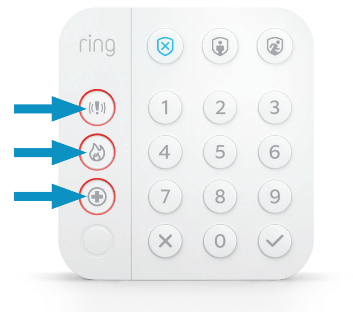Preventing false alarms
Learn how to prevent false alarms on your Ring Alarm. A false alarm is when your alarm is accidentally triggered, despite there being no actual security issue.
How to prevent false alarms
- Add your emergency contacts as Shared Users in the Ring app so that they can arm, disarm, and check on your Ring Alarm.1
- Make sure you disarm the Alarm before opening a door or window. If the alarm is triggered accidentally, disarm within 30 seconds..
- Make sure everyone in your home is comfortable arming and disarming your Ring Alarm with the Keypad using a four-digit access code. False alarms can happen when someone does not enter the correct code. If you quickly disarm your alarm, you should be able to prevent a false alarm.
- Make sure your guests, visitors, and caregivers also can disarm your Ring Alarm using their four-digit Guest User access code. Anyone who can enter your house when you're not around should have a code to operate the system..
- Save the2as a contact in your phone as 'Ring Alarm'. If possible, give this number a unique ringtone to help make sure you don't miss the call.
- If you use Do Not Disturb (DND) on your mobile device, make sure it is set to receive emergency calls from the Ring monitoring service, even when in DND.
- Use your Practice Mode to discover features, adjust settings, andwithout the worry of false alarm or accidental dispatches..
Important note: When the Practice Mode ends, your Ring Alarm will automatically be monitored. At this time, if your Alarm is triggered, you'll get an automated call.
Device-specific tips to avoid false alarms
Contact Sensors
- Correct placement:Make sure you've set up your Contact Sensors correctly. Set a door you often use as Main Door, and set a door you use less frequently as Secondary Door. Always set windows to the Window setting..
- Entry and exit delays:to give you enough time to arrive and leave home.
- Secure doors and windows:Close doors and windows tightly to make sure they are shut. If your door or window opens while armed, it could set off a false alarm.
- Secure Contact Sensors:Securely attach Contact Sensors and magnets to your doors and windows. If your device falls off while armed, it could set off a false alarm.
Motion Detectors
Every room is unique, but consider these suggestions when installing your Motion Detector.
- Correct placement:Install your Motion Detector 2.2 metres off the ground, in the corner of a room, and facing the middle of the room. Don’t install your Motion Detector facing windows, heat sources, or air vents. Learn more about installing your Motion Detector.
- Pets, light changes, and moving objects:Check that motion in your home (including balloons, rotating fans, shiny objects, flickering lights, and curtains placed over an air vent) won’t accidentally set off Motion Detectors. Any movement within your home can trigger the Motion Detector when your Ring Alarm is armed in “Away" mode. You can adjust the sensitivity control for pets and other objects.
- Stairs:Make sure that a Motion Detector is not focused on areas where the elevation abruptly changes.
Test your Motion Detector after installation to ensure that you've selected the best location and settings to accommodate any pets, obstacles, or environmental factors. Testing can help make sure that it's in the right spot to detect people and avoid false alarms.
Panic Alarms
The Panic Alarm feature allows Ring Alarm owners to instantly trigger an emergency response through their Ring Alarm system with the Ring Alarm Panic Button or the Ring Alarm Keypad. Make sure you know how the panic alarm is triggered:
- Panic Button: Press and hold the button for three seconds (red exclamation point in the centre).

- Keypad (2nd Generation) Police/Panic button: Press and hold the Police button (grey exclamation point on the left side) for three seconds.

- Keypad (1st Generation): Press and hold the check mark (✓) and x buttons simultaneously for three seconds.

- Keep your Keypad or Panic Button out of the reach of children and pets to avoid accidentally setting off the alarm.
- If you want to test this functionality without alerting Alarm Calls,. After testing, be sure to toggle back to Alarm Calls.2
Glass Break Sensors
- Correct placement:Avoid placing your Glass Break Sensor on surfaces such as tables or shelves, where items are frequently set down and picked up.
